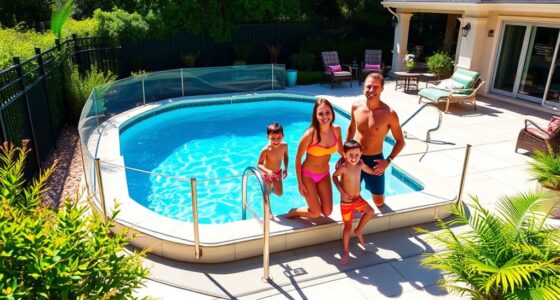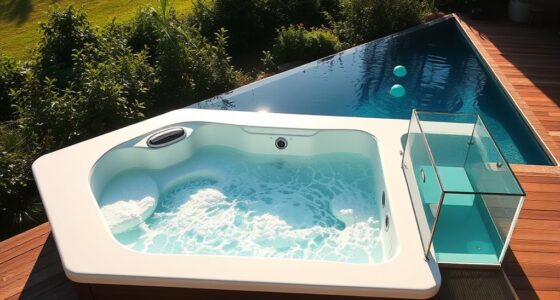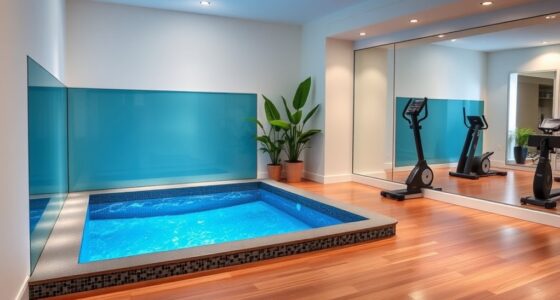Propellers create swim currents by spinning blades that push water backward, generating a reactive force that moves you forward. Jets, on the other hand, force water through nozzles at high speeds, producing powerful, focused currents. While propellers are efficient in calm water, jets offer more control and less turbulence. To understand how these systems harness fluid dynamics for movement and their environmental impacts, keep exploring the details behind each technology.
Key Takeaways
- Propellers generate swim currents by rotating blades that push water backward, creating reactive forward flow based on Newton’s third law.
- Jets produce currents by forcing water at high velocity through nozzles, creating a focused and powerful flow through fluid dynamic principles.
- Propeller-driven currents are generally less controlled and more turbulent, while jet-generated flows are more precise and directed.
- Jets tend to generate less turbulence and noise, reducing ecological disturbance compared to propellers.
- Both systems rely on fluid mechanics but differ in efficiency, environmental impact, and control over the water movement they produce.

Have you ever wondered whether propellers or jets are better for swimming through water? The way they generate swim currents is rooted in different hydrodynamic principles, which influence not only their efficiency but also their environmental impact. Understanding these differences helps you grasp which technology might be more suitable depending on your needs or concerns.
Propellers work by rotating blades that push water backward, creating a reactive force that propels you forward. This process relies on classic hydrodynamic principles—specifically, Newton’s third law: for every action, there’s an equal and opposite reaction. As the blades spin, they accelerate water particles, generating a flow that produces a current. This method is straightforward and has been used for decades in boats and submarines. Because of its simplicity, propeller-driven systems tend to be more energy-efficient at certain speeds, especially when moving through calm water. However, they can also cause significant turbulence and noise, which might disturb aquatic environments or marine life.
Jets, on the other hand, generate swim currents by forcing water through a nozzle at high velocity, often using a pump or turbine system. This process is based on fluid dynamics principles involving the conversion of mechanical energy into kinetic energy. As water is expelled at high speed, it creates a powerful, directed flow that can be used for propulsion or to generate currents. Jets tend to produce more controlled and focused water movement compared to propellers, which can be advantageous in precise applications. From an environmental perspective, jet systems often have a lower footprint because they can be designed to minimize turbulence and reduce noise pollution. They also tend to be more adaptable to different water conditions, making them suitable for environments where ecological impact is a concern.
Both systems influence their surroundings differently. Propellers, while efficient, can cause more disturbance to marine ecosystems, especially if they’re not designed with environmental impact in mind. They might stir up sediments or harm small aquatic creatures. Jets, with their more controlled water flow, generally pose less risk to delicate ecosystems, especially if engineered with eco-friendly materials and noise reduction features. Their ability to generate strong, localized currents also makes them appealing for applications requiring minimal ecological disruption.
Frequently Asked Questions
How Do Different Water Conditions Affect Propeller and Jet Currents?
Different water conditions, like turbulence and flow variability, markedly impact propeller and jet currents. You’ll notice that turbulence causes uneven flow, making currents unpredictable and potentially less effective. For propellers, rough water can reduce efficiency and increase stress on the system. Jets, on the other hand, handle flow variability better, but extreme turbulence can still disrupt their smooth operation. So, water conditions directly influence how well these systems generate and maintain currents.
Can Swim Currents Be Controlled or Manipulated Intentionally?
You can control and manipulate swim currents with specific techniques like adjusting propeller speeds or jet flow directions. Imagine tailoring the water’s movement to your needs, creating targeted currents that guide your journey. Current control involves precise manipulation techniques, such as variable speed controls and directional adjustments, allowing you to shape the flow. This way, you harness natural forces or engineered systems to enhance your swimming experience, making currents work for you rather than against you.
What Safety Measures Are Recommended Around Strong Swim Currents?
You should always prioritize safety around strong swim currents by staying alert and following posted warning signs. Keep a safe distance from safety barriers designed to prevent accidents, and never attempt to swim against powerful currents alone. Always swim with a buddy or under lifeguard supervision. If caught in a strong current, stay calm, float, and signal for help. These measures help reduce risks and guarantee your safety.
How Does the Size of a Vessel Influence Current Strength?
Did you know that larger vessels can generate stronger currents, sometimes up to 15 times more intense than smaller boats? The size of a vessel directly influences current strength because bigger ships displace more water, creating powerful flow patterns. As you navigate, keep in mind that vessel size affects current strength, so always adjust your swimming or boating approach accordingly to stay safe. Larger vessels demand increased caution around their wake and flow.
Are There Environmental Impacts From Propellers and Jets on Aquatic Ecosystems?
Yes, propellers and jets impact aquatic ecosystems. They contribute to marine pollution through fuel emissions and debris, harming marine life. Additionally, they create noise disturbance, which can stress or disorient marine animals like fish and whales. This environmental impact underscores the need for cleaner, quieter propulsion technologies to protect our oceans and preserve aquatic biodiversity.
Conclusion
Now that you know how propellers and jets generate swim currents, it’s clear that each has its own strengths. Whether you’re drawn to the raw power of propellers or the sleek efficiency of jets, understanding these differences helps you make smarter choices. Remember, don’t put all your eggs in one basket—exploring both options gives you a well-rounded view. Keep digging, and you’ll find the perfect fit for your aquatic adventures.










